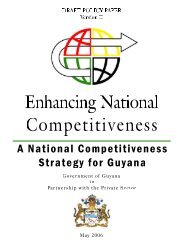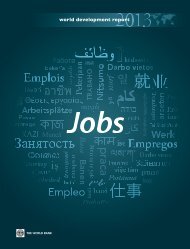Business Removing
Doing Business in 2005 -- Removing Obstacles to Growth
Doing Business in 2005 -- Removing Obstacles to Growth
- No tags were found...
You also want an ePaper? Increase the reach of your titles
YUMPU automatically turns print PDFs into web optimized ePapers that Google loves.
64 DOING BUSINESS IN 2005<br />
FIGURE 8.5<br />
Active case management cuts time<br />
Days between filing and enforcement<br />
Judges do not<br />
actively<br />
manage<br />
Judges<br />
actively<br />
manage<br />
469<br />
278<br />
Poor<br />
countries<br />
Source: Doing <strong>Business</strong> database.<br />
Middle income<br />
countries<br />
529 521<br />
Rich<br />
countries<br />
the case—and nearly 18 months in rich countries where<br />
judges don’t. The same pattern is seen elsewhere (figure<br />
8.5). The reduction in time does not come at higher cost.<br />
Quite the opposite: fees in countries with case management<br />
tend to be lower because attorney costs are lower. 16<br />
Case management involves 2 changes. First, judges<br />
take the responsibility to follow cases from start to finish.<br />
In most countries a debt collection case typically comes<br />
to the judge a dozen times. Without case management<br />
the judge is not aware of how the case is progressing,<br />
depending on other court officials to move the case<br />
along. The second is introducing an electronic system of<br />
recording and following cases from the time they are<br />
filed to the time judgment is issued or the case is withdrawn,<br />
as in Finland. With greater incentives to reach<br />
resolution and better technology, the judge can follow<br />
each case at any moment.<br />
It doesn’t take much time or money to develop a case<br />
management system. Slovakia’s reform started in 1999 as<br />
a pilot in the Banska Bystrica court. 17 Within 6 months<br />
the average time between filing and the first hearing was<br />
cut from 73 days to 27 and the average number of procedures<br />
from 23 to 5, as judges were randomly assigned and<br />
could schedule the hearings without the need for consultation<br />
with court clerks and other judges. The pilot was<br />
scaled up to all district courts in 2002–03. 18 The cost was<br />
minimal: $2 million. Similar case management systems<br />
are now being introduced in Albania and Armenia, with<br />
World Bank support. Progress is benchmarked in the Judicial<br />
Reform Index developed by the American Bar Association<br />
for its work in Central and Eastern Europe. 19<br />
Bosnia and Herzegovina, Macedonia FYR, Moldova, Romania<br />
and Ukraine are assessed as the least advanced in<br />
developing case management.<br />
330<br />
151<br />
Reducing abuse of appeals<br />
When the Portuguese set up courts in Brazil in the<br />
1700s, they brought their civil procedure code, with one<br />
change—appeals were allowed at any point during the<br />
proceedings and an additional level of appeal was introduced.<br />
The ultimate decision lay with the King. The reason<br />
was simple: should a Portuguese be accused of robbing,<br />
killing, defrauding or otherwise damaging the<br />
property of a local, the possibility for “home-bias” of the<br />
judge was greatly reduced if his judgment could be easily<br />
overturned.<br />
Three centuries later, much has changed in Brazil.<br />
But the rules on appeals remain the same. Debtors frequently<br />
abuse their rights of appeal, using it for stalling<br />
enforcement: 88% of judgments in commercial cases are<br />
appealed. 20 And where the judge awards the full request<br />
of compensation to the creditor, appeal is universal<br />
(100%). If this number doesn’t look high, consider this:<br />
in Argentina 13% of judgments are appealed, in Peru<br />
17%, in Mexico 30%.<br />
Appeals on legal issues, a necessary feature of a fair<br />
justice system, are allowed in every country. But they<br />
needn’t suspend the judicial process. It is better to allow<br />
an appeal on all alleged errors but to allow the trial and<br />
enforcement to continue while the appeal is resolved.<br />
This is what Botswana, Chile, France, Greece and 30<br />
other countries do. In countries where appeals suspend<br />
the enforcement of judgment, it takes twice the time to<br />
collect on overdue debt—160 days instead of 80. Yet<br />
users do not consider the procedure fairer, as reported in<br />
Doing <strong>Business</strong> in 2004.<br />
Several countries have reformed their appeals<br />
process. Benin barred appeals during small-claims cases.<br />
Estonia and Finland do not allow appeal during the<br />
summary proceedings. If the debtor wants to dispute<br />
the judgment in these three countries, he would have to<br />
open a new case. Lithuania tripled the fee for appeals,<br />
obliging the debtor to pay all legal costs of the creditor<br />
when the appeal fails. This has reduced appeals considerably.<br />
Other countries, such as Japan, Mexico, Slovakia<br />
and Thailand, allow appeal of the final judgment but do<br />
not allow interlocutory appeal (appeals during the proceedings).<br />
This is associated with a 20% reduction in the<br />
average court delay.<br />
Improving enforcement<br />
In many countries, courts not only deliver judgments,<br />
they try to enforce them. This generally doesn’t work.<br />
Specialized public collection agencies or private enforcers<br />
are usually in a better position to collect debt (figure 8.6).

















